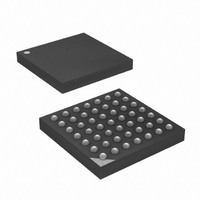ATXMEGA32A4-CU Atmel, ATXMEGA32A4-CU Datasheet - Page 210

ATXMEGA32A4-CU
Manufacturer Part Number
ATXMEGA32A4-CU
Description
MCU AVR 32+4 FLASH 49VFBGA
Manufacturer
Atmel
Series
AVR® XMEGAr
Specifications of ATXMEGA32A4-CU
Core Processor
AVR
Core Size
8/16-Bit
Speed
32MHz
Connectivity
I²C, IrDA, SPI, UART/USART
Peripherals
Brown-out Detect/Reset, DMA, POR, PWM, WDT
Number Of I /o
34
Program Memory Size
32KB (16K x 16)
Program Memory Type
FLASH
Eeprom Size
2K x 8
Ram Size
4K x 8
Voltage - Supply (vcc/vdd)
1.6 V ~ 3.6 V
Data Converters
A/D 12x12b, D/A 2x12b
Oscillator Type
Internal
Operating Temperature
-40°C ~ 85°C
Package / Case
49-VFBGA
Processor Series
ATXMEGA32x
Core
AVR8
Data Bus Width
8 bit, 16 bit
Data Ram Size
4 KB
Interface Type
I2C, SPI, USART
Maximum Clock Frequency
32 MHz
Number Of Programmable I/os
36
Number Of Timers
5
Operating Supply Voltage
1.6 V to 3.6 V
Maximum Operating Temperature
+ 85 C
Mounting Style
SMD/SMT
3rd Party Development Tools
EWAVR, EWAVR-BL
Development Tools By Supplier
ATAVRDRAGON, ATAVRISP2, ATAVRONEKIT
Minimum Operating Temperature
- 40 C
On-chip Adc
12 bit, 1 Channel
On-chip Dac
2 bit, 1 Channel
For Use With
ATAVRONEKIT - KIT AVR/AVR32 DEBUGGER/PROGRMMRATSTK600 - DEV KIT FOR AVR/AVR32770-1007 - ISP 4PORT ATMEL AVR MCU SPI/JTAG770-1004 - ISP 4PORT FOR ATMEL AVR MCU SPI
Lead Free Status / RoHS Status
Lead free / RoHS Compliant
Available stocks
Company
Part Number
Manufacturer
Quantity
Price
- Current page: 210 of 445
- Download datasheet (6Mb)
19.3.7
19.3.8
8077H–AVR–12/09
Clock and Clock Stretching
Arbitration
All devices connected to the bus are allowed to stretch the low period of the clock to slow down
the overall clock frequency or to insert wait states while processing data. A device that needs to
stretch the clock can do this by holding/forcing the SCL line low after it detects a low level on the
line.
Three types of clock stretching can be defined as shown in
Figure 19-8. Clock Stretching
If the device is in a sleep mode and a START condition is detected the clock is stretched during
the wake-up period for the device.
A slave device can slow down the bus frequency by stretching the clock periodically on a bit
level. This allows the slave to run at a lower system clock frequency. However, the overall per-
formance of the bus will be reduced accordingly. Both the master and slave device can
randomly stretch the clock on a byte level basis before and after the ACK/NACK bit. This pro-
vides time to process incoming or prepare outgoing data, or performing other time critical tasks.
In the case where the slave is stretching the clock the master will be forced into a wait-state until
the slave is ready and vice versa.
A master can only start a bus transaction if it has detected that the bus is idle. As the TWI bus is
a multi master bus, it is possible that two devices initiate a transaction at the same time. This
results in multiple masters owning the bus simultaneously. This is solved using an arbitration
scheme where the master loses control of the bus if it is not able to transmit a high level on the
SDA line. The masters who lose arbitration must then wait until the bus becomes idle (i.e. wait
for a STOP condition) before attempting to reacquire bus ownership. Slave devices are not
involved in the arbitration procedure.
SDA
SCL
S
Wakeup clock
stretching
bit 7
bit 6
Periodic clock
stretching
Figure
bit 0
19-8.
ACK/NACK
Random clock
XMEGA A
stretching
210
Related parts for ATXMEGA32A4-CU
Image
Part Number
Description
Manufacturer
Datasheet
Request
R

Part Number:
Description:
DEV KIT FOR AVR/AVR32
Manufacturer:
Atmel
Datasheet:

Part Number:
Description:
INTERVAL AND WIPE/WASH WIPER CONTROL IC WITH DELAY
Manufacturer:
ATMEL Corporation
Datasheet:

Part Number:
Description:
Low-Voltage Voice-Switched IC for Hands-Free Operation
Manufacturer:
ATMEL Corporation
Datasheet:

Part Number:
Description:
MONOLITHIC INTEGRATED FEATUREPHONE CIRCUIT
Manufacturer:
ATMEL Corporation
Datasheet:

Part Number:
Description:
AM-FM Receiver IC U4255BM-M
Manufacturer:
ATMEL Corporation
Datasheet:

Part Number:
Description:
Monolithic Integrated Feature Phone Circuit
Manufacturer:
ATMEL Corporation
Datasheet:

Part Number:
Description:
Multistandard Video-IF and Quasi Parallel Sound Processing
Manufacturer:
ATMEL Corporation
Datasheet:

Part Number:
Description:
High-performance EE PLD
Manufacturer:
ATMEL Corporation
Datasheet:

Part Number:
Description:
8-bit Flash Microcontroller
Manufacturer:
ATMEL Corporation
Datasheet:

Part Number:
Description:
2-Wire Serial EEPROM
Manufacturer:
ATMEL Corporation
Datasheet:











